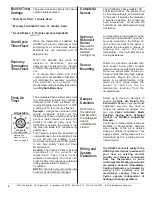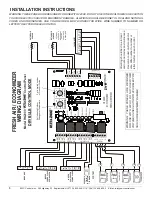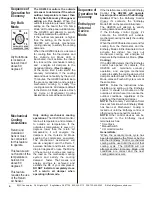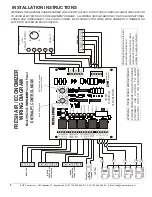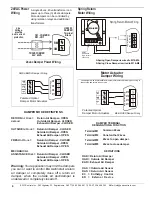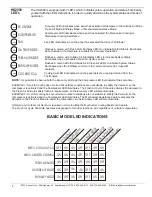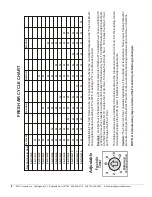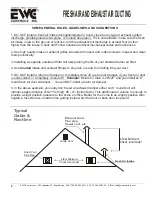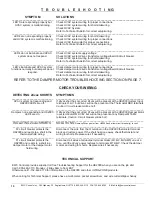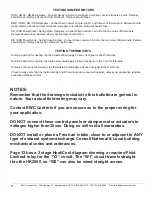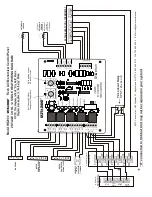
EWC Controls Inc. 385 Highway 33 Englishtown, NJ 07726 800-446-3110 FAX 732-446-5362 E-Mail- info@ewccontrols.com
2
The panel has built-in timers that insure
safe & reliable operation.
When the thermostat is satisfied, the
HK2000 will prevent compressor from
energizing for a 1 minute delay. Heating
demands are not interfered with or
delayed at all.
Built-In Timer
Settings
Short Cycle
Timer-Fixed
* Short Cycle Timer: 1 minute, fixed.
* Economy Termination Timer: 15 minutes, fixed.
* Fresh AirTimer: 0 -12 cycles per hour, Adjustable
SEE PAGE 8
Economy
Termination
Timer-Fixed
When the HK2000 has made the
decision to “Economize," and all
dampers are energized to the “Outside
Air Mode." Mechanical Cooling is locked
out.
A 15 minute timer starts, and if the
cooling call is not satisfied in that time, it
will terminate the economy operation.
T h e H K 2 0 0 0 w i l l e n e r g i z e t h e
mechanical cooling to satisfy the building
load.
Dry Bulb Mode Only.
Fresh Air
Timer
The adjustable fresh air timer can be set
to automatically activate the controlled
dampers to the “Fresh Air Mode” on a
regular schedule. A setting of “0” is OFF.
A setting of “12” is continuous fresh air.
Example:
A single hour is divided into 5
minute increments of fresh air.
The
installer has chosen a setting of 4 cycles
per hour, which results in a total of 20
minutes of fresh air every hour. The
HK2000 will activate the dampers into
the Fresh Air Mode for 5 minutes every
quarter hour.
This helps to reduce the possibility of
complaints due to the introduction of cold
or hot air into the building. It also
minimizes the load on the HVAC system.
It can help satisfy Fresh Air Code
Requirements.
Caution:
The Fresh Air Timer operates
r e g a r d l e s s o f t h e o u t s i d e a i r
temperature. Take proper freeze
protection precautions. Do not set the
Fresh Air Timer for continuous outside air
during extreme winter or summer
Conditions.
NOTE:
A 5 minute delay occurs when the
Fresh Air Cycle Setting is changed.
0
2
4
6
8
10
12
FRESH AIR
CYCLES / HOUR
Adjustable
Outside Air
Sensor
The HK2000 includes a reliable 10K
Thermistor/Sensor. The sensor must
be mounted outdoors, and wired back
to the panel. It provides the processor
a means of reading
the outside dry
bulb temperature.
Used with OA
Temp Mode and Mechanical Cooling
Assistance.
Optional
Return Air
Sensor
Required for
Mechanical
Assisted
Cooling Only
An
Optional Return Air Sensor
can be
connected to the HK2000. The sensor
must be mounted in the Return air
duct, and wired back to the panel. It
provides the processor a means of
r e a d i n g
t h e r e t u r n d r y b u l b
temperature.
Used with Mechanical
Cooling Assistance.
Sensor
Mounting
Follow the directions included with
each sensor. Avoid direct sunlight
when mounting the outside air sensor.
Do not run sensor wires on top of or
inside conduit that carry high voltage
conductors. Mount the return air
sensor in a suitable location in the
return air duct, which allows the
s e n s o r t o r e a d o n l y t h e a i r
temperature returning from the
occupied space.
Damper
Selection
Never close
the return air
damper when
the outside air
duct is
undersized or
closed.
Select up to three (3) dampers to
control:
Outside Air, Return Air,
Exhaust Air.
Based on your particular
application you may only need to
control the outside air damper. You
can use
24vac Actuated; Multi-
Position, Spring Safe, Patented
Optical, or Min/Max Adjustable
Dampers.
Control two or three dampers and use
Min/Max or Multi-position dampers
when mixing of the air is desired
during all modes of operation. Your
actual system configuration will be
determined by the existing and /or
new duct work.
Wiring and
System
Operations
The HK2000 connects easily to the
HVAC System. It wires in series with
your new or existing control
circuitry and receives commands
from the thermostat, or zone
control system. Heating commands
are always honored immediately.
Cooling demands are honored by
u s i n g c o o l o u t s i d e a i r o r
mechanical cooling. Fresh Air
Cycles operate independent of
heating or cooling operations.
Refer to the
Fresh Air Cycle
Chart on page 8


